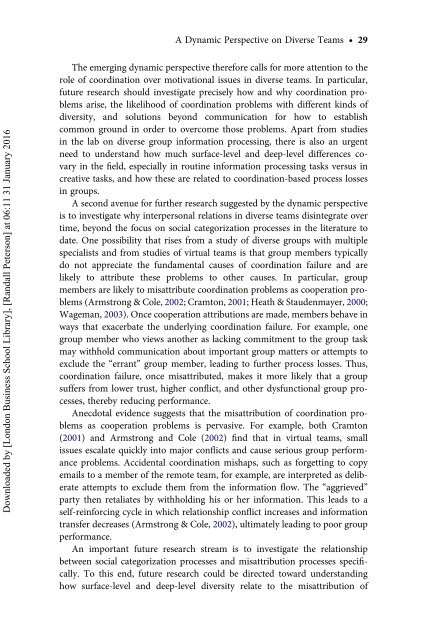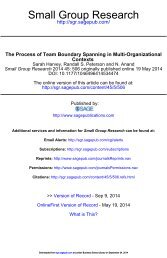A Dynamic Perspective on Diverse Teams: Moving From The Dual Process Model to A Dynamic Coordination-Based Model of Diverse Team Performance - Kannan Srikanth, Sarah Harvey & Randall Peterson
The existing literature on diverse teams suggests that diversity is both helpful to teams in making more information available and encouraging creativity and damaging to teams in reducing cohesion and information sharing. Thus the extant literature suggests that diversity within teams is a double-edged sword that leads to both positive and negative effects simultaneously.
The existing literature on diverse teams suggests that diversity is both helpful to teams in making more information available and encouraging creativity and
damaging to teams in reducing cohesion and information sharing. Thus the
extant literature suggests that diversity within teams is a double-edged sword
that leads to both positive and negative effects simultaneously.
Create successful ePaper yourself
Turn your PDF publications into a flip-book with our unique Google optimized e-Paper software.
A <str<strong>on</strong>g>Dynamic</str<strong>on</strong>g> <str<strong>on</strong>g>Perspective</str<strong>on</strong>g> <strong>on</strong> <strong>Diverse</strong> <strong><strong>Team</strong>s</strong> † 29<br />
Downloaded by [L<strong>on</strong>d<strong>on</strong> Business School Library], [<strong>Randall</strong> Peters<strong>on</strong>] at 06:11 31 January 2016<br />
<strong>The</strong> emerging dynamic perspective therefore calls for more attenti<strong>on</strong> <strong>to</strong> the<br />
role <strong>of</strong> coordinati<strong>on</strong> over motivati<strong>on</strong>al issues in diverse teams. In particular,<br />
future research should investigate precisely how and why coordinati<strong>on</strong> problems<br />
arise, the likelihood <strong>of</strong> coordinati<strong>on</strong> problems with different kinds <strong>of</strong><br />
diversity, and soluti<strong>on</strong>s bey<strong>on</strong>d communicati<strong>on</strong> for how <strong>to</strong> establish<br />
comm<strong>on</strong> ground in order <strong>to</strong> overcome those problems. Apart from studies<br />
in the lab <strong>on</strong> diverse group informati<strong>on</strong> processing, there is also an urgent<br />
need <strong>to</strong> understand how much surface-level and deep-level differences covary<br />
in the field, especially in routine informati<strong>on</strong> processing tasks versus in<br />
creative tasks, and how these are related <strong>to</strong> coordinati<strong>on</strong>-based process losses<br />
in groups.<br />
A sec<strong>on</strong>d avenue for further research suggested by the dynamic perspective<br />
is <strong>to</strong> investigate why interpers<strong>on</strong>al relati<strong>on</strong>s in diverse teams disintegrate over<br />
time, bey<strong>on</strong>d the focus <strong>on</strong> social categorizati<strong>on</strong> processes in the literature <strong>to</strong><br />
date. One possibility that rises from a study <strong>of</strong> diverse groups with multiple<br />
specialists and from studies <strong>of</strong> virtual teams is that group members typically<br />
do not appreciate the fundamental causes <strong>of</strong> coordinati<strong>on</strong> failure and are<br />
likely <strong>to</strong> attribute these problems <strong>to</strong> other causes. In particular, group<br />
members are likely <strong>to</strong> misattribute coordinati<strong>on</strong> problems as cooperati<strong>on</strong> problems<br />
(Armstr<strong>on</strong>g & Cole, 2002; Cramt<strong>on</strong>, 2001; Heath & Staudenmayer, 2000;<br />
Wageman, 2003). Once cooperati<strong>on</strong> attributi<strong>on</strong>s are made, members behave in<br />
ways that exacerbate the underlying coordinati<strong>on</strong> failure. For example, <strong>on</strong>e<br />
group member who views another as lacking commitment <strong>to</strong> the group task<br />
may withhold communicati<strong>on</strong> about important group matters or attempts <strong>to</strong><br />
exclude the “errant” group member, leading <strong>to</strong> further process losses. Thus,<br />
coordinati<strong>on</strong> failure, <strong>on</strong>ce misattributed, makes it more likely that a group<br />
suffers from lower trust, higher c<strong>on</strong>flict, and other dysfuncti<strong>on</strong>al group processes,<br />
thereby reducing performance.<br />
Anecdotal evidence suggests that the misattributi<strong>on</strong> <strong>of</strong> coordinati<strong>on</strong> problems<br />
as cooperati<strong>on</strong> problems is pervasive. For example, both Cramt<strong>on</strong><br />
(2001) and Armstr<strong>on</strong>g and Cole (2002) find that in virtual teams, small<br />
issues escalate quickly in<strong>to</strong> major c<strong>on</strong>flicts and cause serious group performance<br />
problems. Accidental coordinati<strong>on</strong> mishaps, such as forgetting <strong>to</strong> copy<br />
emails <strong>to</strong> a member <strong>of</strong> the remote team, for example, are interpreted as deliberate<br />
attempts <strong>to</strong> exclude them from the informati<strong>on</strong> flow. <strong>The</strong> “aggrieved”<br />
party then retaliates by withholding his or her informati<strong>on</strong>. This leads <strong>to</strong> a<br />
self-reinforcing cycle in which relati<strong>on</strong>ship c<strong>on</strong>flict increases and informati<strong>on</strong><br />
transfer decreases (Armstr<strong>on</strong>g & Cole, 2002), ultimately leading <strong>to</strong> poor group<br />
performance.<br />
An important future research stream is <strong>to</strong> investigate the relati<strong>on</strong>ship<br />
between social categorizati<strong>on</strong> processes and misattributi<strong>on</strong> processes specifically.<br />
To this end, future research could be directed <strong>to</strong>ward understanding<br />
how surface-level and deep-level diversity relate <strong>to</strong> the misattributi<strong>on</strong> <strong>of</strong>
















